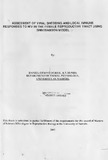| dc.description.abstract | Heterosexual transmission accounts for majority of human immunodeficiency VIruS (HIV)
infection among adults in developing countries. The risk of female to male transmission of HIV
is likely to be determined by concentration of virus and the local immune response to the virus in
the cervicovaginal secretions (CVS) of the infected women. A better understanding of the
correlates of genital shedding of HIV may significantly aid preventive measures aimed at
reducing this transmission. Recent studies suggest a possible role of female genital immune
response in preventing HIV infection. Both local immune response and the viral load in genital
secretions may be influenced by the stage of the menstrual cycle. This may determine when the
female is most vulnerable to HIV infection or can transmit the virus most efficiently. These
issues can only be best investigated in a suitable animal model. Currently, simian
immunodeficiency virus (SfV) infection of macaques is regarded as the best model since it
mimics HIV infection in various ways. However, existing differences in envelope glycoproteins
between the two viruses limit the use of the SIV/macaque model in HIV -1 vaccine trials and for
molecular studies assessing envelope determinants of HIV -1 pathogenicity. Simian/Human
immmunodeficiency virus (SHIV) infection of baboons provides suitable alternative for such
studies. This project assessed the relationship of the menstrual cycle to genital mucosal and
systemic immunity, and to viral shedding within cervicovaginal secretions of female olive
baboons (Papia anubis) experimentally inoculated with SHIV-89.6P.
Cervicovaginal lavage (CVL) and blood from two SHIV-89.6P infected (n=Z) and two
uninfected (n=2) adult female baboons were sampled at three stages namely; menstruation
(men), mid-follicular (mfl) and luteal (Jut) stages of two successive cycles. Isolation of cell-free
XI
virus was attempted from plasma and CVL by limiting culture dilution method. The presence of
virus was confirmed by SIV p27 core antigen assay. SHIV-specific immnoglobulins A (IgA) and
immunoglobulin G (IgG) were detected in both CVL and plasma by ELISA and confirmed by
Hlv-I and Hl V-Z Western blots. Radioimmunoassay (RIA) for estradiol (E2) and progesterone
(P4) in plasma was performed to corroborate the perineal skin swelling with the menstrual cycle
stage.
The cyclical changes in blood levels of E2 and P4 correlated positively with the menstrual cycle
stage as determined by perineal skin swelling. Infected animals were able to secrete SlIlvspecific
antibodies in their genital fluids. Detection of SillV -specific IgA and IgG in CVL
appeared to be influenced by the stage of the menstrual cycle. Similarly, anti-SHIV IgG titers in
CVL varied with the menstrual cycle, being highest during menses, lower in luteal stage and not
detectable in mid-follicular stage of the two successive menstrual cycles. On the other hand, a
menstrual cycle-dependent variation in IgG titers in plasma was not observed, probably
indicating a lack of influence of the menstrual cycle on the presence and titers of anti-Slfl'V
antibodies in systemic circulation of the baboon model. Anti-SillV IgG titers were higher in
plasma than in CVL of infected animals. Virus was isolated from and detected in both plasma
and CVL of SlffV inoculated baboons. However, no consistent cyclic pattern was observed with
respect to the isolation of this virus from either plasma or CVL. The negative control animals
remained virus isolation and SHIV -specific antibody negative throughout the study period.
This project has shown that SillV infected female baboons shed virus in their genital secretions.
A strong local humoral response to the virus, dependent on the phase of the cycle, is present
XII
within the genital tract. The observed hormonal regulation of SHIV -specific secretory immunity
may have important implications for preventive measurers aimed at reducing female to male
transmission· of HIV. In order to be more effective such approaches need to consider the
menstrual cycle phase of women. Given the number of animals used in this study the results
presented here are limited. If developed further, SHIV infection of baboon can provide an
alternative model for investigating unresolved issues in heterosexual transmission of HIV. | en |

